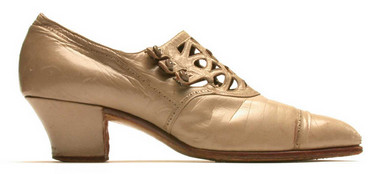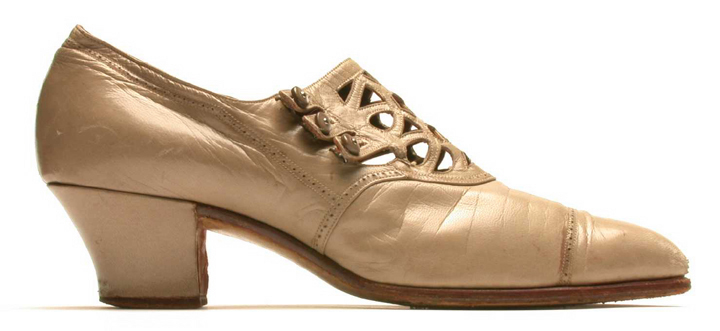Woman's Cream Shoe, 1920s, Original
Fashionable and well-made, this 1920s leather button shoe was produced in a factory. Machine stitching can be seen on the leather sole and upper. The colour is somewhere between beige and khaki and the leather has been polished smooth. The toe panel has been reinforced to be more hard-wearing. A pattern has been cut out of the leather on the front, and there are three grey buttons to hold the panel securely in place. Double-stitching and small punched holes also provide decoration. The leather-covered heel hides a wooden core.
On the arch on the inside of the shoe, there is a 'CHB' trademark, and the words 'British Arch Preserver Shoe.' This type of shoe claimed to preserve the arch in the wearer's feet. In the 1920s, this relatively new development came about with improvements in shoe design so that the sole curved and followed the line of the arch in the foot. The built-in arch bridge supported the wearer's feet, and the shoes were comfortable. Other old-style types of footwear didn't provide the same support - the arch was then in danger of dropping, to leave the wearer with flat feet and an ungainly walk!
This shoe is sturdy and suited to the demands of the 1920s woman who may have worn it to work, to walk or to dance. There are scuff marks on the sole and heel, the upper is creased and there is a tear in one of the straps, which shows that the shoe was well worn, and possibly well-loved too.
The shoe is 10" /25cm long and approximately size 5/6 (there are no size markings on the shoe). It has a 2" heel.
On the arch on the inside of the shoe, there is a 'CHB' trademark, and the words 'British Arch Preserver Shoe.' This type of shoe claimed to preserve the arch in the wearer's feet. In the 1920s, this relatively new development came about with improvements in shoe design so that the sole curved and followed the line of the arch in the foot. The built-in arch bridge supported the wearer's feet, and the shoes were comfortable. Other old-style types of footwear didn't provide the same support - the arch was then in danger of dropping, to leave the wearer with flat feet and an ungainly walk!
This shoe is sturdy and suited to the demands of the 1920s woman who may have worn it to work, to walk or to dance. There are scuff marks on the sole and heel, the upper is creased and there is a tear in one of the straps, which shows that the shoe was well worn, and possibly well-loved too.
The shoe is 10" /25cm long and approximately size 5/6 (there are no size markings on the shoe). It has a 2" heel.

These shoes were made in a factory around 1920. Shoe manufacturing revolutionised footwear and fashions in this period. In the 1900s many shoes were still made by hand by cobblers in workshops. This was a slow process, shoes were pricey and many people had just one pair that lasted several years. Shoemaking was revolutionised once machinery was employed to create shoes. Designs were more adventurous and used innovative materials and creative shapes. Mass production meant lower prices and shoes became a fashion accessory, something easy and affordable.
During the First World War, a shortage in materials and the need to have practical long-lasting footwear meant that people usually wore boots. But as hemlines began to rise the leg came into full view. The foot became the focal point of fashion and women selected shoes for their colour, pattern and detailing. Lace-ups, straps, court shoes or pumps were worn depending on the occasion. Suede in dull greens, greys, mauve and khaki was popular at different times in the 1910s and 20s.
Fashionable shoes also had to be practical. During the War women had taken over jobs in the factories and offices while the men went to fight in Europe. They needed suitable shoes for driving vans, manning railway signal boxes and for serving in the police force and the women's services. At the end of the war, women continued to lead active, independent lives. Sports and leisure interests for women - like cycling, cricket and athletics - were growing in popularity and required comfortable shoes.
Shoe styles were influenced by crazes like the Charleston, a dance that demanded a securely fastened shoe with a low heel and closed toe. The most common styles were shoes with a single strap, covered button and pointed toe, and they were called Mary Janes. There were variations on this style - shoes could have crossover straps, cut-away decorations or t-straps.
The new 'Arch Preserver Shoe' claimed to keep feet 'active and vigorous' and the Hollywood actress Louise Brooks had a pair of arch preserver Mary Janes named in her honour.
The 1920s was the era of the flapper girl, who wore straight drop-waisted dresses with bobbed hairstyles and close-fitting hats. Skirts fell between the knee and mid-calf for both day and evening wear. Layered jacket, blouse and skirt sets were also fashionable and sometimes came in knitted materials. Popular colours for day were neutral greys, browns and blues and designs were simple. Sleeveless barrel-shaped dresses with beading and panels were worn in the evening, and outfits were accessorised with furs, feathers and lace.
During the First World War, a shortage in materials and the need to have practical long-lasting footwear meant that people usually wore boots. But as hemlines began to rise the leg came into full view. The foot became the focal point of fashion and women selected shoes for their colour, pattern and detailing. Lace-ups, straps, court shoes or pumps were worn depending on the occasion. Suede in dull greens, greys, mauve and khaki was popular at different times in the 1910s and 20s.
Fashionable shoes also had to be practical. During the War women had taken over jobs in the factories and offices while the men went to fight in Europe. They needed suitable shoes for driving vans, manning railway signal boxes and for serving in the police force and the women's services. At the end of the war, women continued to lead active, independent lives. Sports and leisure interests for women - like cycling, cricket and athletics - were growing in popularity and required comfortable shoes.
Shoe styles were influenced by crazes like the Charleston, a dance that demanded a securely fastened shoe with a low heel and closed toe. The most common styles were shoes with a single strap, covered button and pointed toe, and they were called Mary Janes. There were variations on this style - shoes could have crossover straps, cut-away decorations or t-straps.
The new 'Arch Preserver Shoe' claimed to keep feet 'active and vigorous' and the Hollywood actress Louise Brooks had a pair of arch preserver Mary Janes named in her honour.
The 1920s was the era of the flapper girl, who wore straight drop-waisted dresses with bobbed hairstyles and close-fitting hats. Skirts fell between the knee and mid-calf for both day and evening wear. Layered jacket, blouse and skirt sets were also fashionable and sometimes came in knitted materials. Popular colours for day were neutral greys, browns and blues and designs were simple. Sleeveless barrel-shaped dresses with beading and panels were worn in the evening, and outfits were accessorised with furs, feathers and lace.


Fashionable and well-made, this 1920s leather button shoe was produced in a factory. Machine stitching can be seen on the leather sole and upper. The colour is somewhere between beige and khaki and the leather has been polished smooth. The toe panel has been reinforced to be more hard-wearing. A pattern has been cut out of the leather on the front, and there are three grey buttons to hold the panel securely in place. Double-stitching and small punched holes also provide decoration. The leather-covered heel hides a wooden core.
On the arch on the inside of the shoe, there is a 'CHB' trademark, and the words 'British Arch Preserver Shoe.' This type of shoe claimed to preserve the arch in the wearer's feet. In the 1920s, this relatively new development came about with improvements in shoe design so that the sole curved and followed the line of the arch in the foot. The built-in arch bridge supported the wearer's feet, and the shoes were comfortable. Other old-style types of footwear didn't provide the same support - the arch was then in danger of dropping, to leave the wearer with flat feet and an ungainly walk!
This shoe is sturdy and suited to the demands of the 1920s woman who may have worn it to work, to walk or to dance. There are scuff marks on the sole and heel, the upper is creased and there is a tear in one of the straps, which shows that the shoe was well worn, and possibly well-loved too.
The shoe is 10" /25cm long and approximately size 5/6 (there are no size markings on the shoe). It has a 2" heel.
On the arch on the inside of the shoe, there is a 'CHB' trademark, and the words 'British Arch Preserver Shoe.' This type of shoe claimed to preserve the arch in the wearer's feet. In the 1920s, this relatively new development came about with improvements in shoe design so that the sole curved and followed the line of the arch in the foot. The built-in arch bridge supported the wearer's feet, and the shoes were comfortable. Other old-style types of footwear didn't provide the same support - the arch was then in danger of dropping, to leave the wearer with flat feet and an ungainly walk!
This shoe is sturdy and suited to the demands of the 1920s woman who may have worn it to work, to walk or to dance. There are scuff marks on the sole and heel, the upper is creased and there is a tear in one of the straps, which shows that the shoe was well worn, and possibly well-loved too.
The shoe is 10" /25cm long and approximately size 5/6 (there are no size markings on the shoe). It has a 2" heel.
- Term:
- Description:
- Arch preserver shoe
- A shoe with a concealed built-in bridge. The sole of the shoe curves to follow the natural line of the foot, providing support to the wearer's arch.
- Charleston
- A ballroom dance of the 1920s named after Charleston, South Carolina, USA where it was a popular Black dance in the early 1900s. It had a fast rhythm and involved side kicking and swinging movements of the body, plus twisting toe-in steps.
- Drop-waisted dress
- A dress with a low waist that hangs around the hips.
- Flapper girl
- 1920s slang, used to refer to young, lively and often unconventional women.
- Louise Brooks
- A film actress and fashion icon of the 1920s.
- Mary Janes
- The most popular type of shoe in the 1920s. It had a single strap, covered button, pointed toe and a high shapely heel.




















